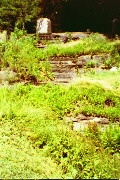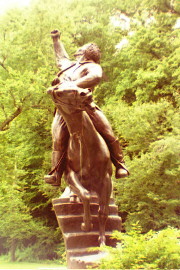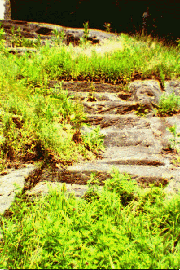

"A captain and thirty men were sent from our advanced lines from Horseneck who discovered the enemy at New Rochelle, in advance. They retired before them undiscovered as far as Rye Neck, where, it growing light, the enemy observed and attacked them. They defended themselves as well as possible and made their way good to Sawpitts, where they took advantage of a commanding piece of ground and made some little stand, but the superior force of the enemy obliged them to retire over Byram bridge, which they took up, and by that means had an opportunity of reaching Horseneck in safety."
Arriving at Horseneck at full gallop, Captain Hosmer and his riders had just time to alarm the camp when Tryon and his marauders appeared in sight, about nine o'clock on Friday morning, February 26th. Traditions differ as to just where Putnam was at this hour. According to one account, he was staying with General Ebenezer Mead, a member of the Committee of Safety, and was in the front chamber, shaving. Suddenly he saw in the mirror, before which he was standing, a reflection of the red-coats advancing from the west. Half-shaven and with the lather still on his face, he grasped his sword, rushed out of the house, mounted his horse and started at high speed for the hill, half a mile distant, to rally his troops. (This hill, on which the Congregational meeting-house stood, was not the one down which Putnam made his famous ride. That hill was near the Episcopal Church. Some writers have become confused by not making this distinction in describing the place of the exploit.) Another tradition says that Putnam was at the house of Captain John Hobby, which was located much nearer the hill, and that when the enemy approached, walking their horses, they saw Putnam with his coat on his arm, spring on his horse and gallop towards his men. The prevailing current of authority seems to indicate that Putnam was at the tavern kept by Israel Knapp, aftwards known as the Tracy place, and which was situated a short distance west of the brow of the precipice at Horseneck. But wherever the General was alarmed that morning, he was soon with his men on the hill where the Congregational meeting-house stood, and made rapid preparations to resist the British. It is most interesting to have his official report, dated March 2, 1779, to Governor Trumbull, giving certain details of the affair:
"As I was there myself," says Putnam, "to see the situation of the guards, I had the troops formed on a hill by the [Congregational] meeting-house, ready to receive the enemy as they advanced."
The Americans numbered about one hundred and fifty - a force only one-tenth of the number under Tryon. Putnam coutinues by describing the approach of the hostile troops:
"They came on briskly, and I soon discovered that the design was to turn our flanks and possess themselves of a defile in our rear, which would effectually prevent our retreat. I therefore ordered parties out on both flanks, with directions to give me information of their approach, that we might retire in season. In the meantime a column advanced up the main road, where the remainder of the troops (amounting to only about sixty were posted."
On came the soldiers of King George; dragoons and infantry ready to charge. In the van were some of the most vindictive foes, - Delancey's corps of Tories.
"We discharged some old field pieces," says Putnam, "which were there, a few times, and gave them a small fire of musketry, but without any considerable effect; the superior force of the enemy soon obliged our small detachment to abandon the place. I therefore directed the troops to retire and form on a hill a little distance from Horseneck, while I proceeded to Stamford and collected a body of militia and a few Continental troops which were there, with which I returned immediately."
But Putnam omits to mention what happened just after he had ordered his men to retreat a short distance across a swamp to a place inaccessible to horses, while he himself went for reinforcements. When he wheeled his horse into the main road towards Stamford, several British dragoons started to pursue him. He saw them coming. Over the frozen highway sped the General. The ring of steel-shod hoofs behind him told him how fast the enemy's chargers were gaining upon him. Onward the old hero spurred, while the flying horsemen lessened the distance between themselves and their prize. A fourth of a mile was passed in the mad chase, and then the road curved sharply toward the north and led round a steep declivity. Out from the highway the intrepid Putnam leaped his steed and dashed straight on towards the precipice and forced his horse over the brow and down the rocky height. His pursuers - one of them had just been within two lengths of him on the road - reined in their horses in utter astonishment at sight of the General's reckless feat, and, not daring to follow him down the dangerous steep, fired their revolvers* [sic] at him as he went. An eye-witness of the exploit used to tell bow Putnam waved back his sword with taunting words to the baffled British, whose balls whizzed past him. One of the bullets pierced his military cap.

Traditions differ as to just the course which the hero took in his descent. One is that he went down the entire length of an irregular rocky stairway, formed by seventy or more rough stones, so arranged as make a convenient approach from the plain below to the Episcopal Church, which stood near the crest of the Horseneck height. The other version says that Putnnam followed a cow-path diagonally across the hill and when he reached the stone steps he was two-thirds from the top. In either case, he reached the foot at the spot which is pointed out today. The hill, now called Putnam's or Put's Hill, has been cut through since Revolutionary days, and a causeway has been made at its base across the plain or meadow. When Lafayette, with whom Putnam probably became acquainted at White Plains in the autumn of 1778, visited the United States in 1824-25, he stopped at Greenwich on his tour through Connecticut. He was met by a large gathering of people, who accompanied him to the scene Putnam's adventure, where an arch had been erected for the occasion. Lafayette left his carriage and walked down the hill, telling the members of the reception committee his great interest in the characteristic exploit of the General.

The centennial commemoration of the renowned ride was observed with appropriate exercises at Greenwich in February, 1879. A granite boulder monument, bearing a tablet and inscription, was placed in 1900 on the historic hill to mark the locality of Putnam's remarkable feat. This memorial emphasises with vivid reality that although, on the one hand, the exploit has been disputed by some writers of Revolutionary events, and, on the other hand, has been romantically exaggerated in story-books and in numberless quaint drawings, paintings, and prints, - still Putnam's ride is well authenticated and can continue to be a favorite tale concerning the intrepid hero.
On that eventful day in Putnam's career, it appears that, in a farmhouse situated about half a mile below the hill, a mother, busy over her milk-pans, heard the rapid beat of horse-hoofs coming down the road which led past the house. She rushed to the door to look for her four little girls, who had been playing outside and who might be in danger of being trampled upon. 'The hatless General, his long hair blowing about his round, kindly face, dashed up in front of the house and drew up his horse so suddenly as to pull his back on his haunches. "For God's sake, take your children in," Putnam called to the mother. "The British are upon us." After this momentary halt - an act of thoughtfulness, like that of a personal friend to warn the mother to find a hiding-place for her family, - the General put spurs to his horse and sped on towards Stamford. When Putnam returned to Horseneck with a reinforcement, which he obtained at Stamford, he found the enemy gone. They had destroyed the salt works as well as a sloop and store at Coscob, and had pillaged many of the houses in Greenwich.
"The officer commanding the Continental troops stationed at Horseneck," writes Putnam, referring to Colonel Holdridge, whom he had ordered to retreat a short distance with the men that morning, while he himself rode to Stamford for help, "mistook my orders and went much farther than I intended, so that he could not come up with them [the British] to any advantage. I, however, ordered the few troops that came from Stamford to pursue them, thinking they might have an opportunity to pick up some stragglers. In this I was not mistaken, as your Excellency [Governor Trumbull] will see by the list of prisoners. Besides these, eight or nine more were taken and sent off, so that I cannot tell to which particular regiments they belonged; one ammunition and one baggage wagon were taken. In the former there were about two hundred rounds of canister, grape, and round shot, suited to three-pounders, some slow matches, and about two hundred tubes; the latter was filled with plunder, which I had the satisfaction of restoring to the inhabitants from whom it was taken. As I have not yet got a return, I cannot tell exactly the number we lost, though I don't think more than ten soldiers and about that number of inhabitants, but a few of which were in arms."
List of prisoners taken at Horseneck the 26th [February]: 17th Regiment, 15 privates; 44th do., 5 privates; 57th do., 3 privates; Loyal American Regiment, 5; Emmerick's corps, 8; First Battalion of Artillery, 1; Pioneers, 1-Total 38. N.B. Seven deserters from Emmerick's corps."
In appreciation of Putnam's kind treatment of the wounded prisoners, who were soon afterwards exchanged, and also in recognition of his bravery in making the perilous descent at Horseneck, Governor Tryon is said to have sent the General the present of a new suit of military clothes, including a chapeau to replace the cap which was pierced by the British bullet.